Organisational Behaviour Report: Understanding Employee Behavior
VerifiedAdded on 2020/12/09
|12
|3554
|482
Report
AI Summary
This report provides a comprehensive overview of organisational behaviour, examining its core concepts and impact on organisational success. It delves into key areas such as understanding human behaviour in the workplace, team dynamics, motivation, leadership styles, and organisational culture. The report highlights the importance of organisational behaviour in enhancing employee performance, fostering positive work environments, and improving overall organisational effectiveness. Factors influencing organisational behaviour, including people, structure, technology, environment, and leadership, are analysed. The report also discusses challenges in today's environment and ways to address them. The content is contributed by a student and available on Desklib, a platform that provides AI-based study tools, past papers, and solved assignments to students.
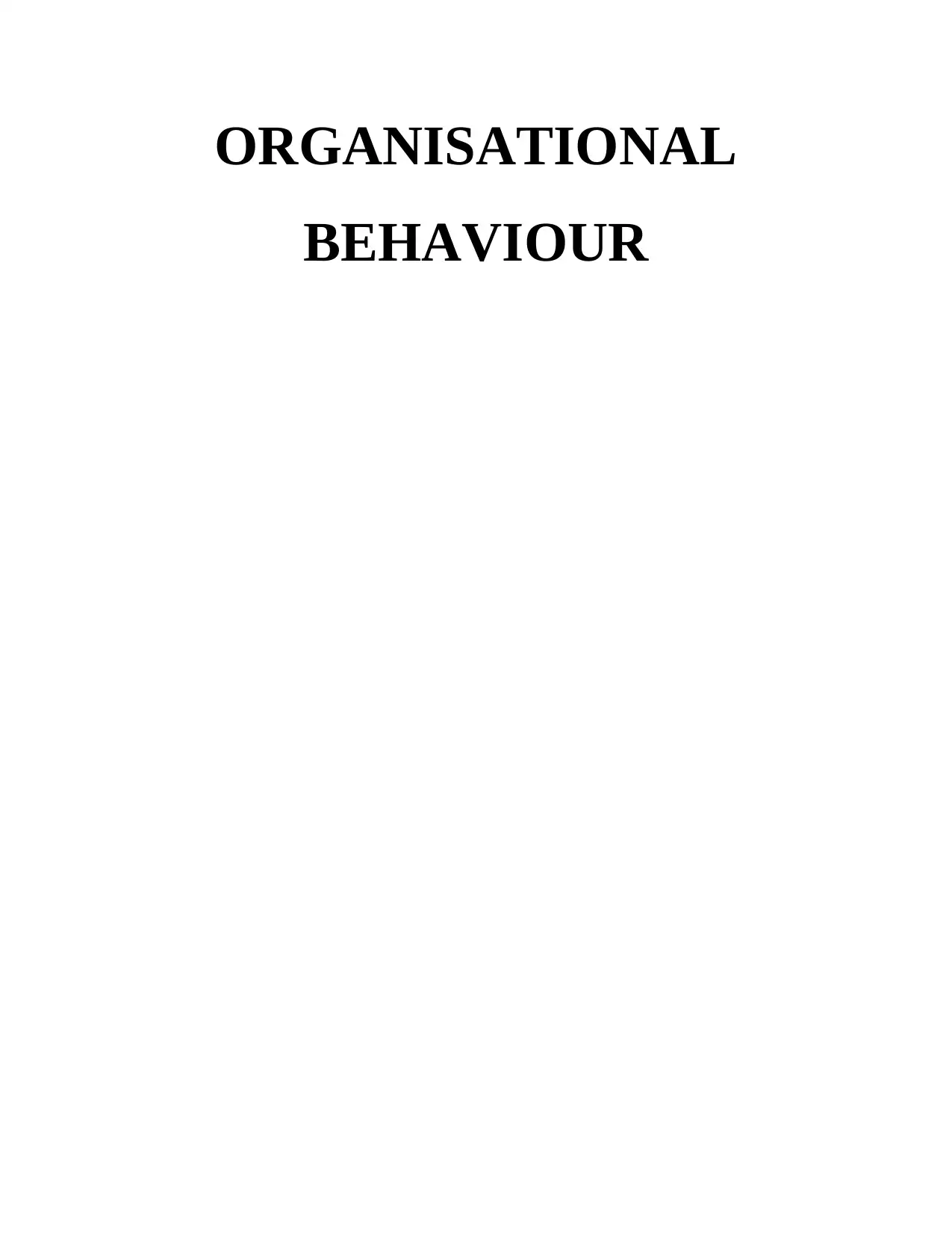
ORGANISATIONAL
BEHAVIOUR
BEHAVIOUR
Paraphrase This Document
Need a fresh take? Get an instant paraphrase of this document with our AI Paraphraser
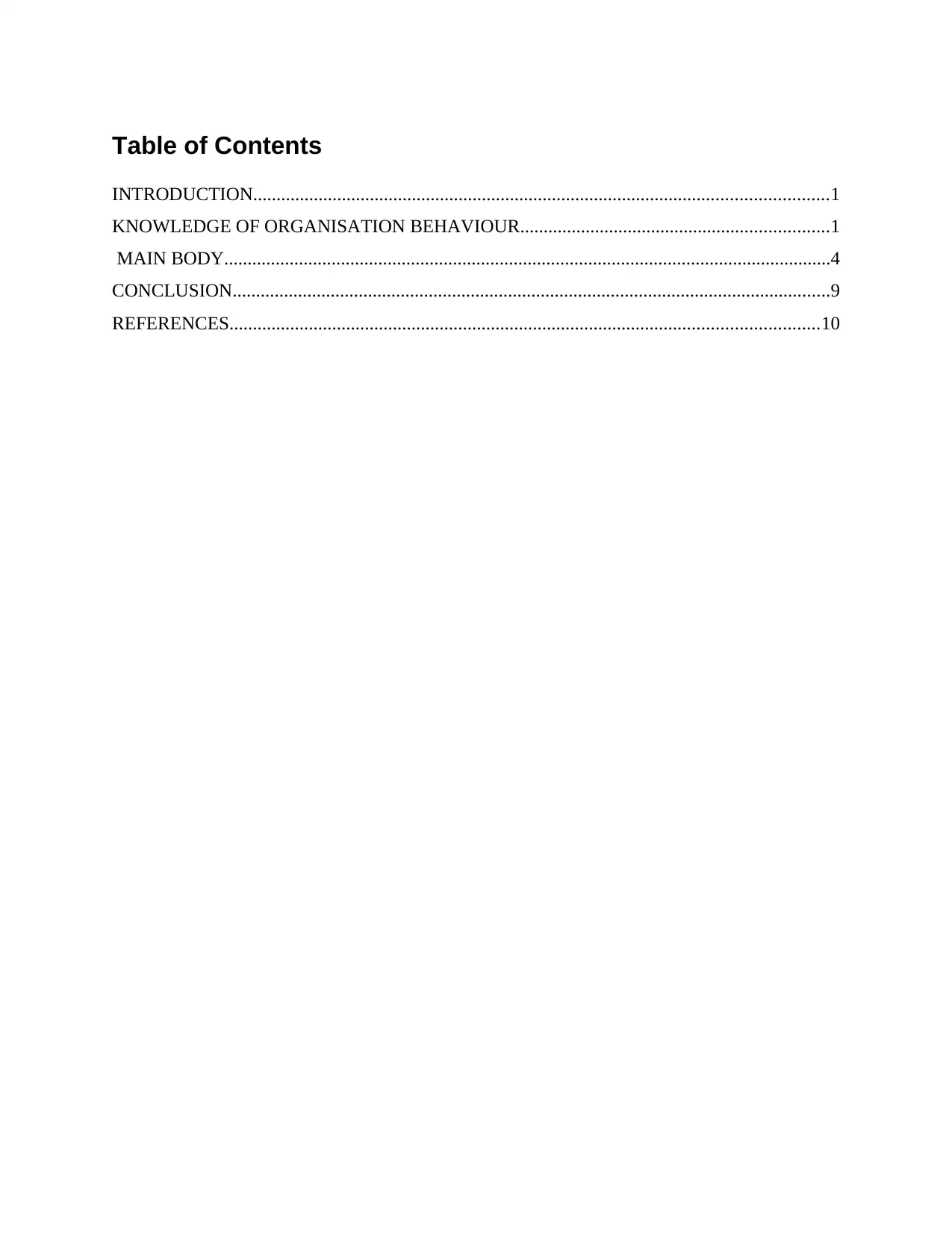
Table of Contents
INTRODUCTION...........................................................................................................................1
KNOWLEDGE OF ORGANISATION BEHAVIOUR..................................................................1
MAIN BODY..................................................................................................................................4
CONCLUSION................................................................................................................................9
REFERENCES..............................................................................................................................10
INTRODUCTION...........................................................................................................................1
KNOWLEDGE OF ORGANISATION BEHAVIOUR..................................................................1
MAIN BODY..................................................................................................................................4
CONCLUSION................................................................................................................................9
REFERENCES..............................................................................................................................10
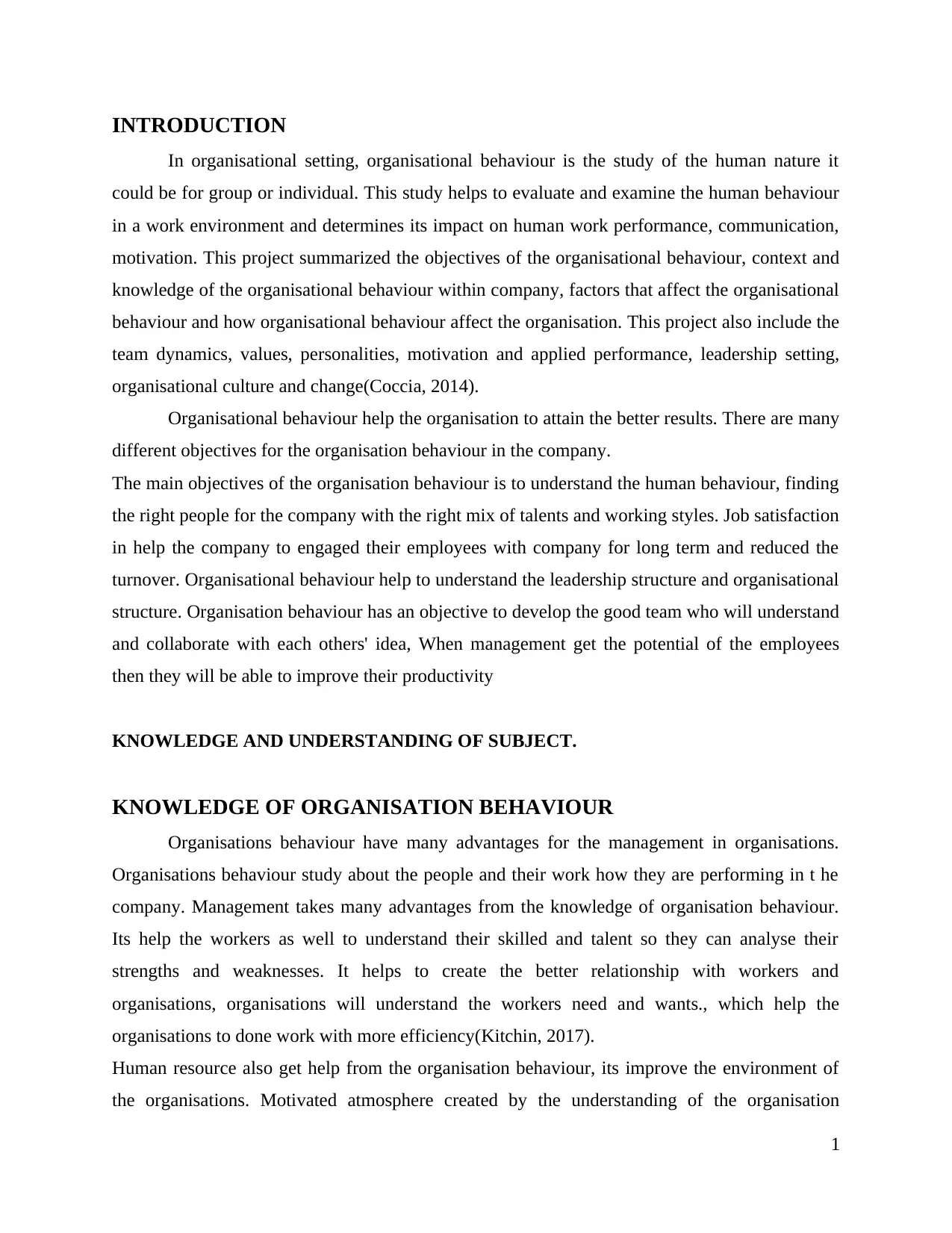
INTRODUCTION
In organisational setting, organisational behaviour is the study of the human nature it
could be for group or individual. This study helps to evaluate and examine the human behaviour
in a work environment and determines its impact on human work performance, communication,
motivation. This project summarized the objectives of the organisational behaviour, context and
knowledge of the organisational behaviour within company, factors that affect the organisational
behaviour and how organisational behaviour affect the organisation. This project also include the
team dynamics, values, personalities, motivation and applied performance, leadership setting,
organisational culture and change(Coccia, 2014).
Organisational behaviour help the organisation to attain the better results. There are many
different objectives for the organisation behaviour in the company.
The main objectives of the organisation behaviour is to understand the human behaviour, finding
the right people for the company with the right mix of talents and working styles. Job satisfaction
in help the company to engaged their employees with company for long term and reduced the
turnover. Organisational behaviour help to understand the leadership structure and organisational
structure. Organisation behaviour has an objective to develop the good team who will understand
and collaborate with each others' idea, When management get the potential of the employees
then they will be able to improve their productivity
KNOWLEDGE AND UNDERSTANDING OF SUBJECT.
KNOWLEDGE OF ORGANISATION BEHAVIOUR
Organisations behaviour have many advantages for the management in organisations.
Organisations behaviour study about the people and their work how they are performing in t he
company. Management takes many advantages from the knowledge of organisation behaviour.
Its help the workers as well to understand their skilled and talent so they can analyse their
strengths and weaknesses. It helps to create the better relationship with workers and
organisations, organisations will understand the workers need and wants., which help the
organisations to done work with more efficiency(Kitchin, 2017).
Human resource also get help from the organisation behaviour, its improve the environment of
the organisations. Motivated atmosphere created by the understanding of the organisation
1
In organisational setting, organisational behaviour is the study of the human nature it
could be for group or individual. This study helps to evaluate and examine the human behaviour
in a work environment and determines its impact on human work performance, communication,
motivation. This project summarized the objectives of the organisational behaviour, context and
knowledge of the organisational behaviour within company, factors that affect the organisational
behaviour and how organisational behaviour affect the organisation. This project also include the
team dynamics, values, personalities, motivation and applied performance, leadership setting,
organisational culture and change(Coccia, 2014).
Organisational behaviour help the organisation to attain the better results. There are many
different objectives for the organisation behaviour in the company.
The main objectives of the organisation behaviour is to understand the human behaviour, finding
the right people for the company with the right mix of talents and working styles. Job satisfaction
in help the company to engaged their employees with company for long term and reduced the
turnover. Organisational behaviour help to understand the leadership structure and organisational
structure. Organisation behaviour has an objective to develop the good team who will understand
and collaborate with each others' idea, When management get the potential of the employees
then they will be able to improve their productivity
KNOWLEDGE AND UNDERSTANDING OF SUBJECT.
KNOWLEDGE OF ORGANISATION BEHAVIOUR
Organisations behaviour have many advantages for the management in organisations.
Organisations behaviour study about the people and their work how they are performing in t he
company. Management takes many advantages from the knowledge of organisation behaviour.
Its help the workers as well to understand their skilled and talent so they can analyse their
strengths and weaknesses. It helps to create the better relationship with workers and
organisations, organisations will understand the workers need and wants., which help the
organisations to done work with more efficiency(Kitchin, 2017).
Human resource also get help from the organisation behaviour, its improve the environment of
the organisations. Motivated atmosphere created by the understanding of the organisation
1
⊘ This is a preview!⊘
Do you want full access?
Subscribe today to unlock all pages.

Trusted by 1+ million students worldwide
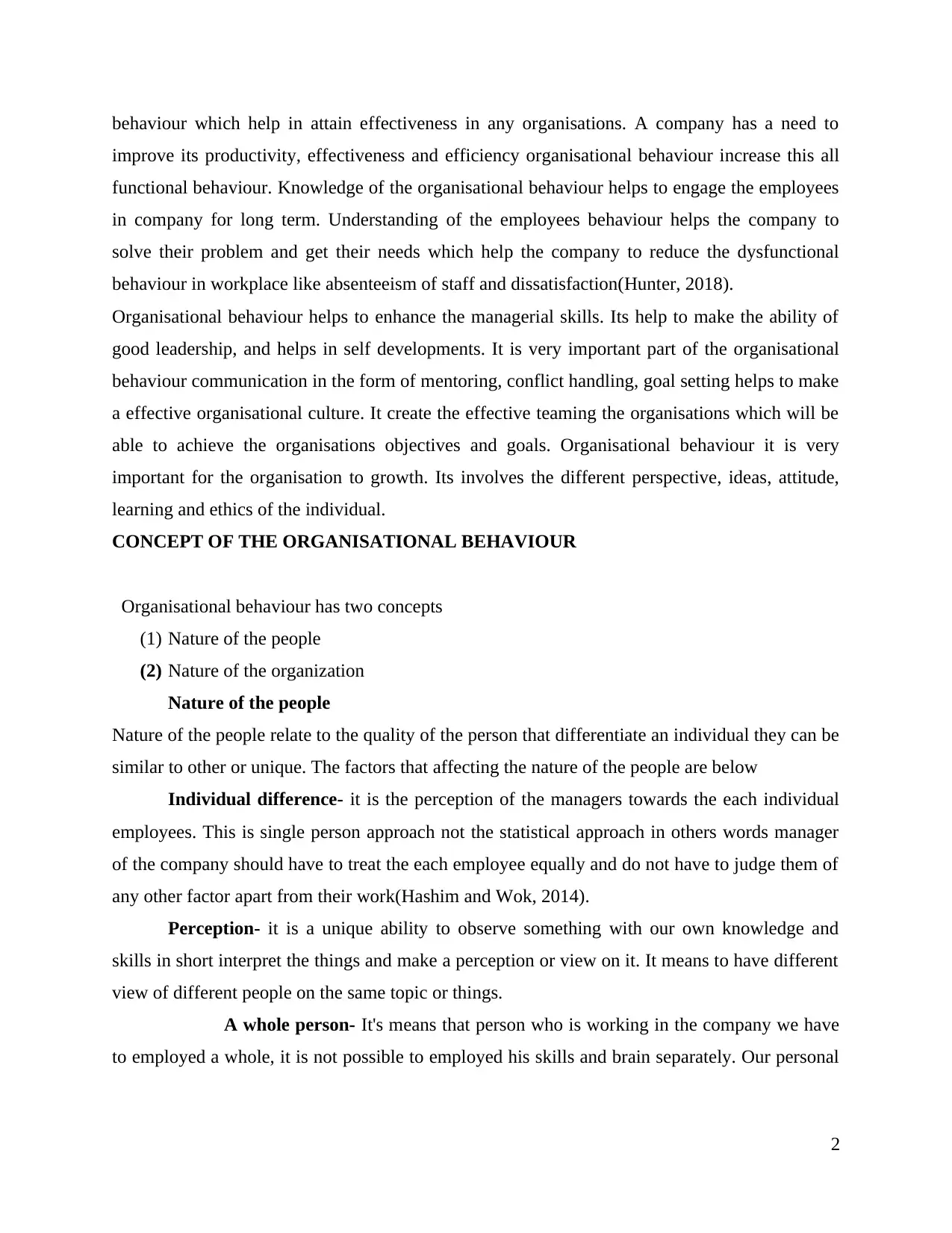
behaviour which help in attain effectiveness in any organisations. A company has a need to
improve its productivity, effectiveness and efficiency organisational behaviour increase this all
functional behaviour. Knowledge of the organisational behaviour helps to engage the employees
in company for long term. Understanding of the employees behaviour helps the company to
solve their problem and get their needs which help the company to reduce the dysfunctional
behaviour in workplace like absenteeism of staff and dissatisfaction(Hunter, 2018).
Organisational behaviour helps to enhance the managerial skills. Its help to make the ability of
good leadership, and helps in self developments. It is very important part of the organisational
behaviour communication in the form of mentoring, conflict handling, goal setting helps to make
a effective organisational culture. It create the effective teaming the organisations which will be
able to achieve the organisations objectives and goals. Organisational behaviour it is very
important for the organisation to growth. Its involves the different perspective, ideas, attitude,
learning and ethics of the individual.
CONCEPT OF THE ORGANISATIONAL BEHAVIOUR
Organisational behaviour has two concepts
(1) Nature of the people
(2) Nature of the organization
Nature of the people
Nature of the people relate to the quality of the person that differentiate an individual they can be
similar to other or unique. The factors that affecting the nature of the people are below
Individual difference- it is the perception of the managers towards the each individual
employees. This is single person approach not the statistical approach in others words manager
of the company should have to treat the each employee equally and do not have to judge them of
any other factor apart from their work(Hashim and Wok, 2014).
Perception- it is a unique ability to observe something with our own knowledge and
skills in short interpret the things and make a perception or view on it. It means to have different
view of different people on the same topic or things.
A whole person- It's means that person who is working in the company we have
to employed a whole, it is not possible to employed his skills and brain separately. Our personal
2
improve its productivity, effectiveness and efficiency organisational behaviour increase this all
functional behaviour. Knowledge of the organisational behaviour helps to engage the employees
in company for long term. Understanding of the employees behaviour helps the company to
solve their problem and get their needs which help the company to reduce the dysfunctional
behaviour in workplace like absenteeism of staff and dissatisfaction(Hunter, 2018).
Organisational behaviour helps to enhance the managerial skills. Its help to make the ability of
good leadership, and helps in self developments. It is very important part of the organisational
behaviour communication in the form of mentoring, conflict handling, goal setting helps to make
a effective organisational culture. It create the effective teaming the organisations which will be
able to achieve the organisations objectives and goals. Organisational behaviour it is very
important for the organisation to growth. Its involves the different perspective, ideas, attitude,
learning and ethics of the individual.
CONCEPT OF THE ORGANISATIONAL BEHAVIOUR
Organisational behaviour has two concepts
(1) Nature of the people
(2) Nature of the organization
Nature of the people
Nature of the people relate to the quality of the person that differentiate an individual they can be
similar to other or unique. The factors that affecting the nature of the people are below
Individual difference- it is the perception of the managers towards the each individual
employees. This is single person approach not the statistical approach in others words manager
of the company should have to treat the each employee equally and do not have to judge them of
any other factor apart from their work(Hashim and Wok, 2014).
Perception- it is a unique ability to observe something with our own knowledge and
skills in short interpret the things and make a perception or view on it. It means to have different
view of different people on the same topic or things.
A whole person- It's means that person who is working in the company we have
to employed a whole, it is not possible to employed his skills and brain separately. Our personal
2
Paraphrase This Document
Need a fresh take? Get an instant paraphrase of this document with our AI Paraphraser
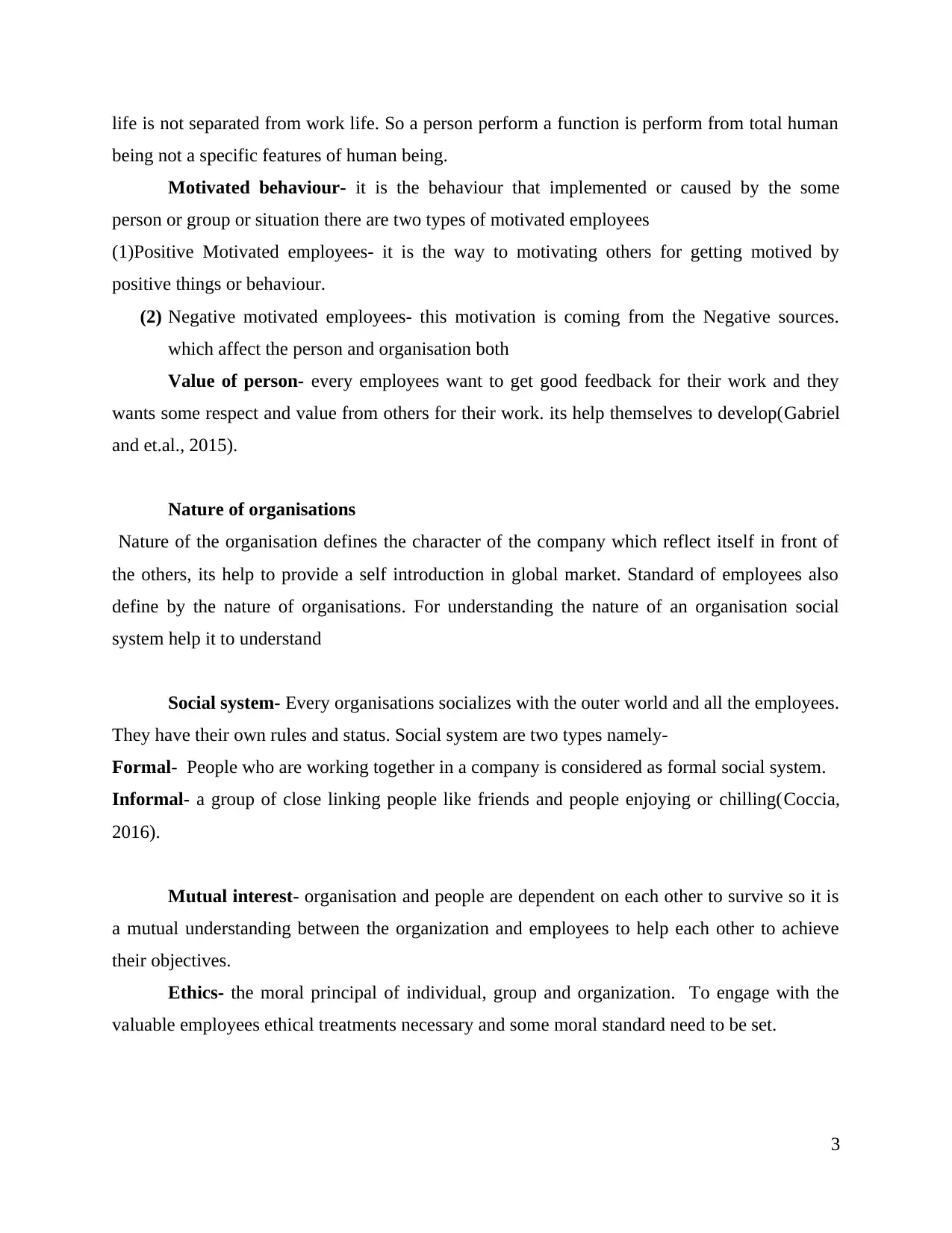
life is not separated from work life. So a person perform a function is perform from total human
being not a specific features of human being.
Motivated behaviour- it is the behaviour that implemented or caused by the some
person or group or situation there are two types of motivated employees
(1)Positive Motivated employees- it is the way to motivating others for getting motived by
positive things or behaviour.
(2) Negative motivated employees- this motivation is coming from the Negative sources.
which affect the person and organisation both
Value of person- every employees want to get good feedback for their work and they
wants some respect and value from others for their work. its help themselves to develop(Gabriel
and et.al., 2015).
Nature of organisations
Nature of the organisation defines the character of the company which reflect itself in front of
the others, its help to provide a self introduction in global market. Standard of employees also
define by the nature of organisations. For understanding the nature of an organisation social
system help it to understand
Social system- Every organisations socializes with the outer world and all the employees.
They have their own rules and status. Social system are two types namely-
Formal- People who are working together in a company is considered as formal social system.
Informal- a group of close linking people like friends and people enjoying or chilling(Coccia,
2016).
Mutual interest- organisation and people are dependent on each other to survive so it is
a mutual understanding between the organization and employees to help each other to achieve
their objectives.
Ethics- the moral principal of individual, group and organization. To engage with the
valuable employees ethical treatments necessary and some moral standard need to be set.
3
being not a specific features of human being.
Motivated behaviour- it is the behaviour that implemented or caused by the some
person or group or situation there are two types of motivated employees
(1)Positive Motivated employees- it is the way to motivating others for getting motived by
positive things or behaviour.
(2) Negative motivated employees- this motivation is coming from the Negative sources.
which affect the person and organisation both
Value of person- every employees want to get good feedback for their work and they
wants some respect and value from others for their work. its help themselves to develop(Gabriel
and et.al., 2015).
Nature of organisations
Nature of the organisation defines the character of the company which reflect itself in front of
the others, its help to provide a self introduction in global market. Standard of employees also
define by the nature of organisations. For understanding the nature of an organisation social
system help it to understand
Social system- Every organisations socializes with the outer world and all the employees.
They have their own rules and status. Social system are two types namely-
Formal- People who are working together in a company is considered as formal social system.
Informal- a group of close linking people like friends and people enjoying or chilling(Coccia,
2016).
Mutual interest- organisation and people are dependent on each other to survive so it is
a mutual understanding between the organization and employees to help each other to achieve
their objectives.
Ethics- the moral principal of individual, group and organization. To engage with the
valuable employees ethical treatments necessary and some moral standard need to be set.
3
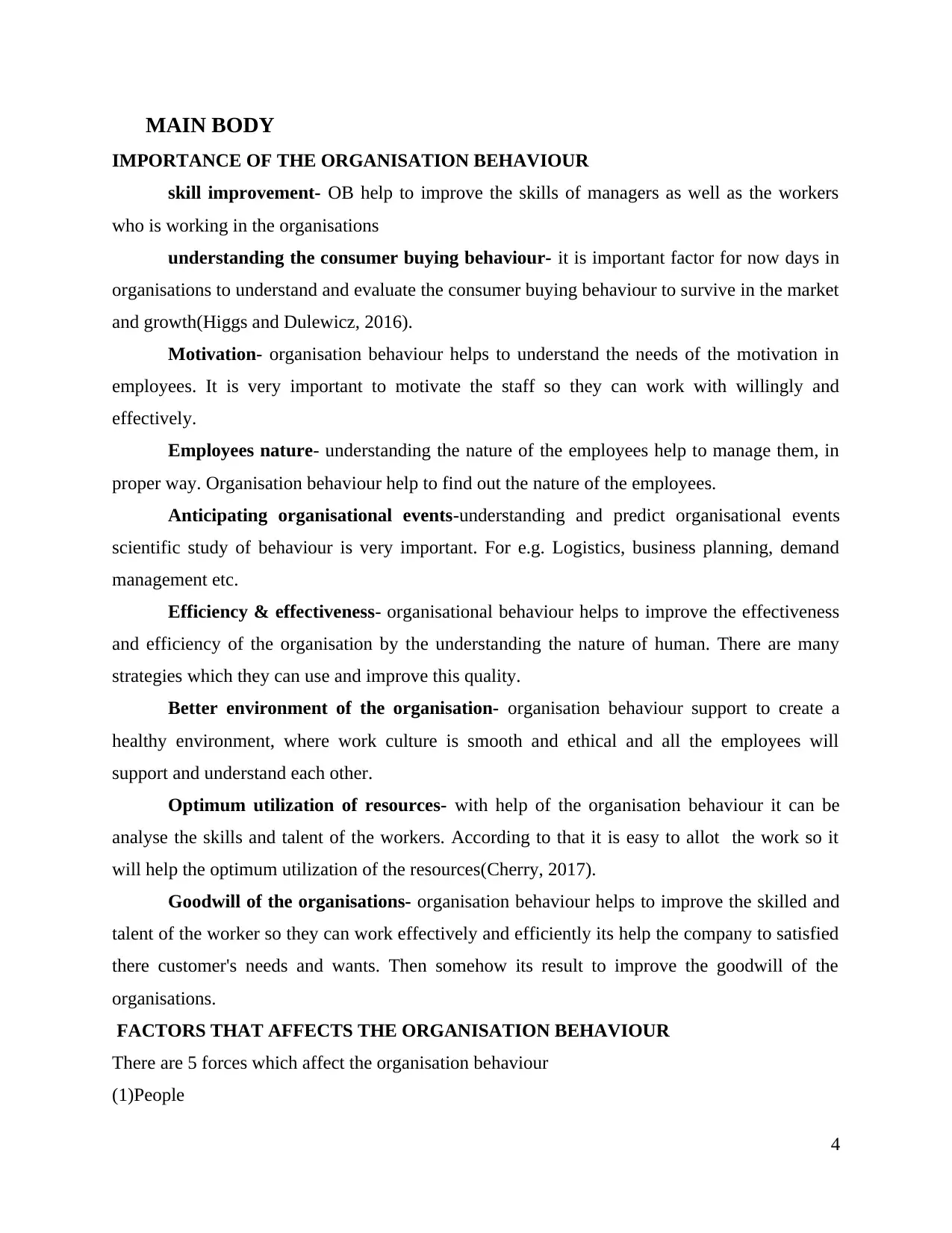
MAIN BODY
IMPORTANCE OF THE ORGANISATION BEHAVIOUR
skill improvement- OB help to improve the skills of managers as well as the workers
who is working in the organisations
understanding the consumer buying behaviour- it is important factor for now days in
organisations to understand and evaluate the consumer buying behaviour to survive in the market
and growth(Higgs and Dulewicz, 2016).
Motivation- organisation behaviour helps to understand the needs of the motivation in
employees. It is very important to motivate the staff so they can work with willingly and
effectively.
Employees nature- understanding the nature of the employees help to manage them, in
proper way. Organisation behaviour help to find out the nature of the employees.
Anticipating organisational events-understanding and predict organisational events
scientific study of behaviour is very important. For e.g. Logistics, business planning, demand
management etc.
Efficiency & effectiveness- organisational behaviour helps to improve the effectiveness
and efficiency of the organisation by the understanding the nature of human. There are many
strategies which they can use and improve this quality.
Better environment of the organisation- organisation behaviour support to create a
healthy environment, where work culture is smooth and ethical and all the employees will
support and understand each other.
Optimum utilization of resources- with help of the organisation behaviour it can be
analyse the skills and talent of the workers. According to that it is easy to allot the work so it
will help the optimum utilization of the resources(Cherry, 2017).
Goodwill of the organisations- organisation behaviour helps to improve the skilled and
talent of the worker so they can work effectively and efficiently its help the company to satisfied
there customer's needs and wants. Then somehow its result to improve the goodwill of the
organisations.
FACTORS THAT AFFECTS THE ORGANISATION BEHAVIOUR
There are 5 forces which affect the organisation behaviour
(1)People
4
IMPORTANCE OF THE ORGANISATION BEHAVIOUR
skill improvement- OB help to improve the skills of managers as well as the workers
who is working in the organisations
understanding the consumer buying behaviour- it is important factor for now days in
organisations to understand and evaluate the consumer buying behaviour to survive in the market
and growth(Higgs and Dulewicz, 2016).
Motivation- organisation behaviour helps to understand the needs of the motivation in
employees. It is very important to motivate the staff so they can work with willingly and
effectively.
Employees nature- understanding the nature of the employees help to manage them, in
proper way. Organisation behaviour help to find out the nature of the employees.
Anticipating organisational events-understanding and predict organisational events
scientific study of behaviour is very important. For e.g. Logistics, business planning, demand
management etc.
Efficiency & effectiveness- organisational behaviour helps to improve the effectiveness
and efficiency of the organisation by the understanding the nature of human. There are many
strategies which they can use and improve this quality.
Better environment of the organisation- organisation behaviour support to create a
healthy environment, where work culture is smooth and ethical and all the employees will
support and understand each other.
Optimum utilization of resources- with help of the organisation behaviour it can be
analyse the skills and talent of the workers. According to that it is easy to allot the work so it
will help the optimum utilization of the resources(Cherry, 2017).
Goodwill of the organisations- organisation behaviour helps to improve the skilled and
talent of the worker so they can work effectively and efficiently its help the company to satisfied
there customer's needs and wants. Then somehow its result to improve the goodwill of the
organisations.
FACTORS THAT AFFECTS THE ORGANISATION BEHAVIOUR
There are 5 forces which affect the organisation behaviour
(1)People
4
⊘ This is a preview!⊘
Do you want full access?
Subscribe today to unlock all pages.

Trusted by 1+ million students worldwide
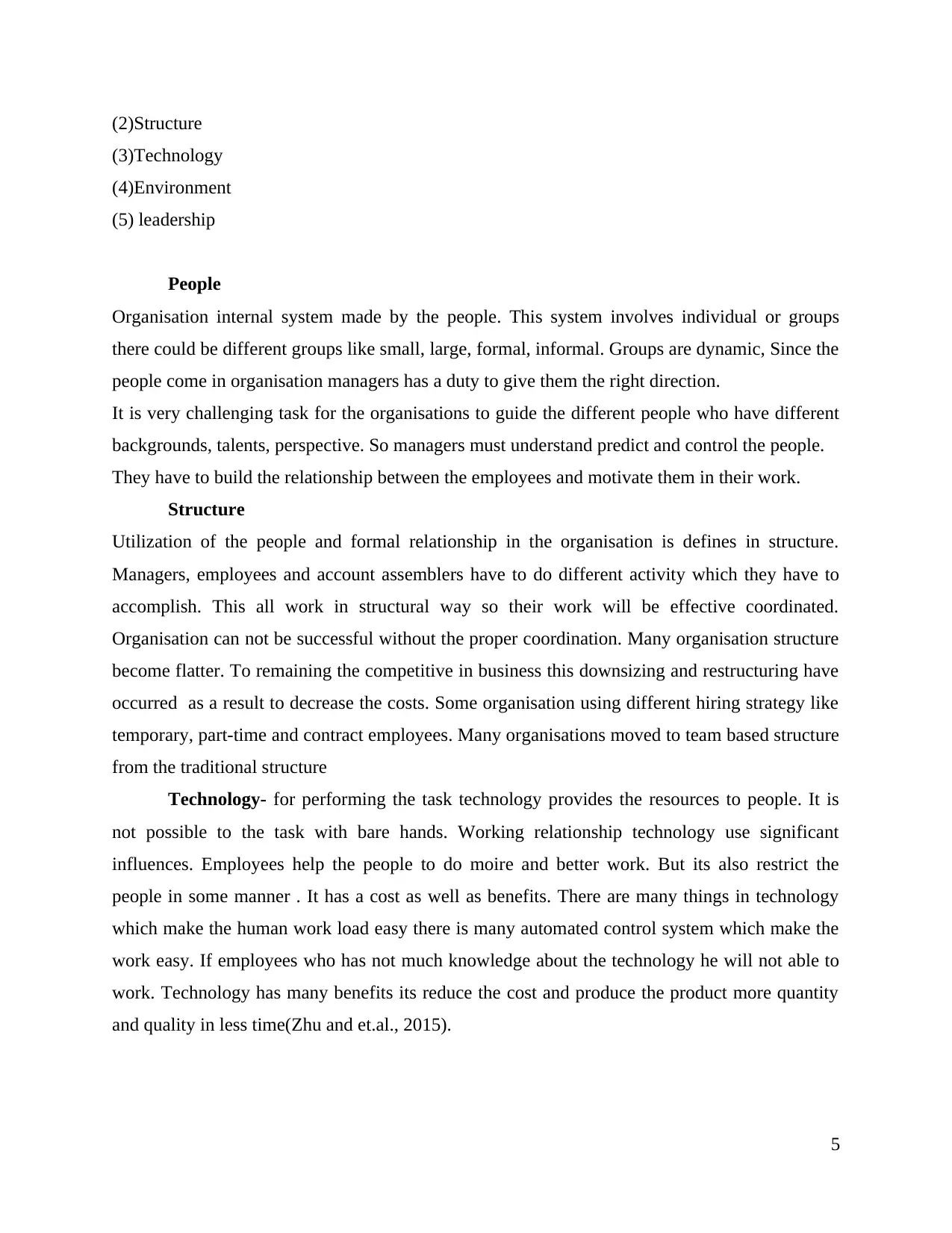
(2)Structure
(3)Technology
(4)Environment
(5) leadership
People
Organisation internal system made by the people. This system involves individual or groups
there could be different groups like small, large, formal, informal. Groups are dynamic, Since the
people come in organisation managers has a duty to give them the right direction.
It is very challenging task for the organisations to guide the different people who have different
backgrounds, talents, perspective. So managers must understand predict and control the people.
They have to build the relationship between the employees and motivate them in their work.
Structure
Utilization of the people and formal relationship in the organisation is defines in structure.
Managers, employees and account assemblers have to do different activity which they have to
accomplish. This all work in structural way so their work will be effective coordinated.
Organisation can not be successful without the proper coordination. Many organisation structure
become flatter. To remaining the competitive in business this downsizing and restructuring have
occurred as a result to decrease the costs. Some organisation using different hiring strategy like
temporary, part-time and contract employees. Many organisations moved to team based structure
from the traditional structure
Technology- for performing the task technology provides the resources to people. It is
not possible to the task with bare hands. Working relationship technology use significant
influences. Employees help the people to do moire and better work. But its also restrict the
people in some manner . It has a cost as well as benefits. There are many things in technology
which make the human work load easy there is many automated control system which make the
work easy. If employees who has not much knowledge about the technology he will not able to
work. Technology has many benefits its reduce the cost and produce the product more quantity
and quality in less time(Zhu and et.al., 2015).
5
(3)Technology
(4)Environment
(5) leadership
People
Organisation internal system made by the people. This system involves individual or groups
there could be different groups like small, large, formal, informal. Groups are dynamic, Since the
people come in organisation managers has a duty to give them the right direction.
It is very challenging task for the organisations to guide the different people who have different
backgrounds, talents, perspective. So managers must understand predict and control the people.
They have to build the relationship between the employees and motivate them in their work.
Structure
Utilization of the people and formal relationship in the organisation is defines in structure.
Managers, employees and account assemblers have to do different activity which they have to
accomplish. This all work in structural way so their work will be effective coordinated.
Organisation can not be successful without the proper coordination. Many organisation structure
become flatter. To remaining the competitive in business this downsizing and restructuring have
occurred as a result to decrease the costs. Some organisation using different hiring strategy like
temporary, part-time and contract employees. Many organisations moved to team based structure
from the traditional structure
Technology- for performing the task technology provides the resources to people. It is
not possible to the task with bare hands. Working relationship technology use significant
influences. Employees help the people to do moire and better work. But its also restrict the
people in some manner . It has a cost as well as benefits. There are many things in technology
which make the human work load easy there is many automated control system which make the
work easy. If employees who has not much knowledge about the technology he will not able to
work. Technology has many benefits its reduce the cost and produce the product more quantity
and quality in less time(Zhu and et.al., 2015).
5
Paraphrase This Document
Need a fresh take? Get an instant paraphrase of this document with our AI Paraphraser
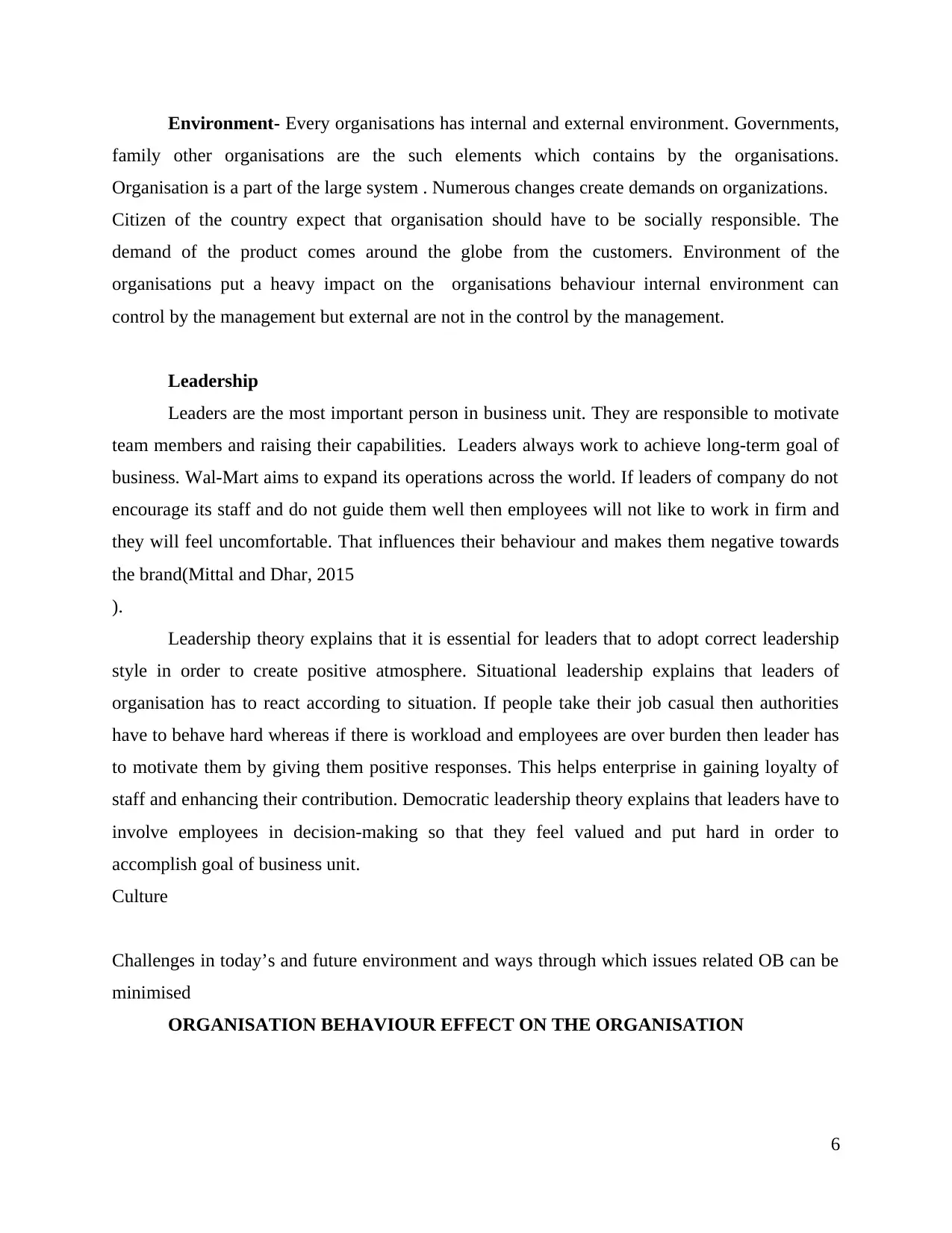
Environment- Every organisations has internal and external environment. Governments,
family other organisations are the such elements which contains by the organisations.
Organisation is a part of the large system . Numerous changes create demands on organizations.
Citizen of the country expect that organisation should have to be socially responsible. The
demand of the product comes around the globe from the customers. Environment of the
organisations put a heavy impact on the organisations behaviour internal environment can
control by the management but external are not in the control by the management.
Leadership
Leaders are the most important person in business unit. They are responsible to motivate
team members and raising their capabilities. Leaders always work to achieve long-term goal of
business. Wal-Mart aims to expand its operations across the world. If leaders of company do not
encourage its staff and do not guide them well then employees will not like to work in firm and
they will feel uncomfortable. That influences their behaviour and makes them negative towards
the brand(Mittal and Dhar, 2015
).
Leadership theory explains that it is essential for leaders that to adopt correct leadership
style in order to create positive atmosphere. Situational leadership explains that leaders of
organisation has to react according to situation. If people take their job casual then authorities
have to behave hard whereas if there is workload and employees are over burden then leader has
to motivate them by giving them positive responses. This helps enterprise in gaining loyalty of
staff and enhancing their contribution. Democratic leadership theory explains that leaders have to
involve employees in decision-making so that they feel valued and put hard in order to
accomplish goal of business unit.
Culture
Challenges in today’s and future environment and ways through which issues related OB can be
minimised
ORGANISATION BEHAVIOUR EFFECT ON THE ORGANISATION
6
family other organisations are the such elements which contains by the organisations.
Organisation is a part of the large system . Numerous changes create demands on organizations.
Citizen of the country expect that organisation should have to be socially responsible. The
demand of the product comes around the globe from the customers. Environment of the
organisations put a heavy impact on the organisations behaviour internal environment can
control by the management but external are not in the control by the management.
Leadership
Leaders are the most important person in business unit. They are responsible to motivate
team members and raising their capabilities. Leaders always work to achieve long-term goal of
business. Wal-Mart aims to expand its operations across the world. If leaders of company do not
encourage its staff and do not guide them well then employees will not like to work in firm and
they will feel uncomfortable. That influences their behaviour and makes them negative towards
the brand(Mittal and Dhar, 2015
).
Leadership theory explains that it is essential for leaders that to adopt correct leadership
style in order to create positive atmosphere. Situational leadership explains that leaders of
organisation has to react according to situation. If people take their job casual then authorities
have to behave hard whereas if there is workload and employees are over burden then leader has
to motivate them by giving them positive responses. This helps enterprise in gaining loyalty of
staff and enhancing their contribution. Democratic leadership theory explains that leaders have to
involve employees in decision-making so that they feel valued and put hard in order to
accomplish goal of business unit.
Culture
Challenges in today’s and future environment and ways through which issues related OB can be
minimised
ORGANISATION BEHAVIOUR EFFECT ON THE ORGANISATION
6
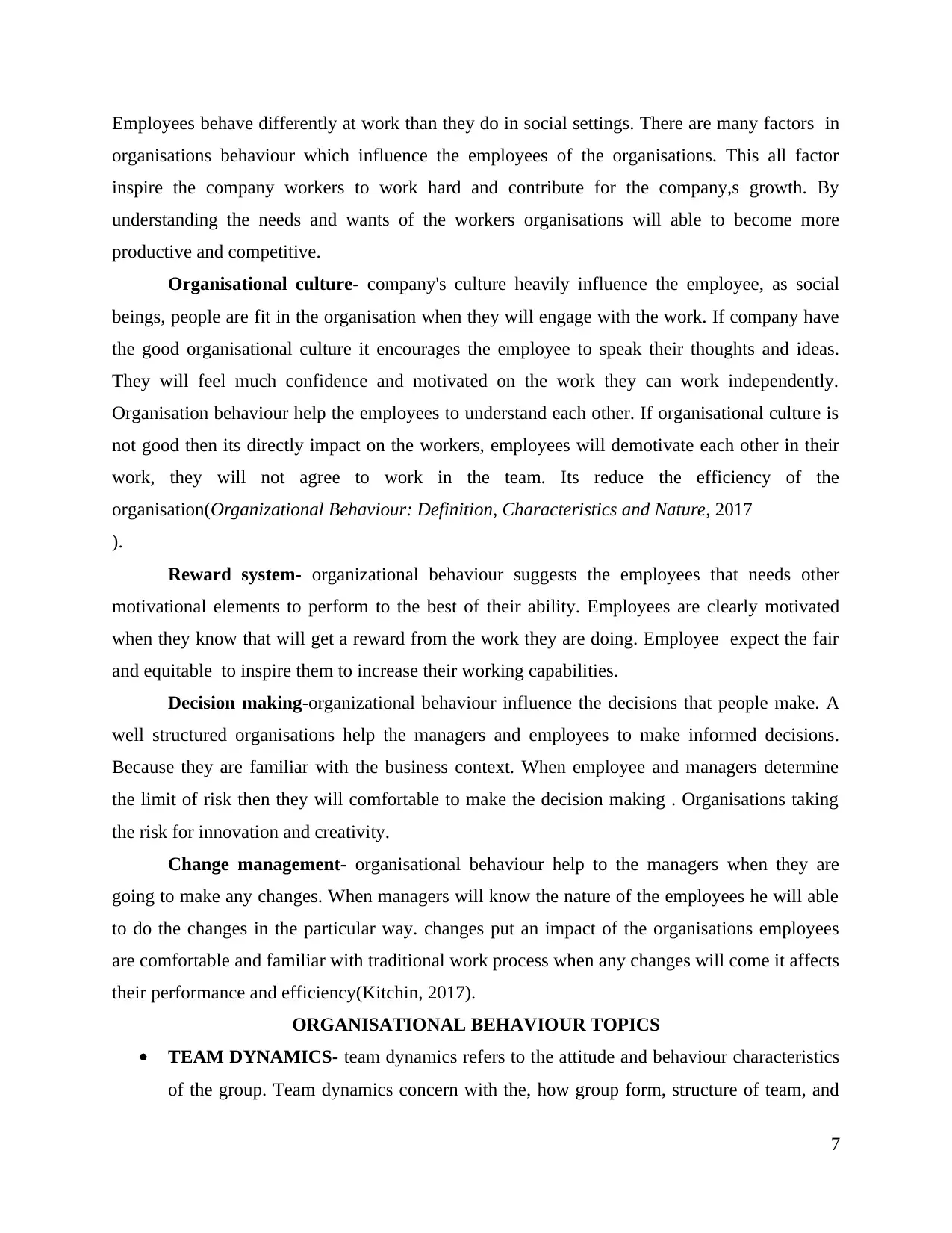
Employees behave differently at work than they do in social settings. There are many factors in
organisations behaviour which influence the employees of the organisations. This all factor
inspire the company workers to work hard and contribute for the company,s growth. By
understanding the needs and wants of the workers organisations will able to become more
productive and competitive.
Organisational culture- company's culture heavily influence the employee, as social
beings, people are fit in the organisation when they will engage with the work. If company have
the good organisational culture it encourages the employee to speak their thoughts and ideas.
They will feel much confidence and motivated on the work they can work independently.
Organisation behaviour help the employees to understand each other. If organisational culture is
not good then its directly impact on the workers, employees will demotivate each other in their
work, they will not agree to work in the team. Its reduce the efficiency of the
organisation(Organizational Behaviour: Definition, Characteristics and Nature, 2017
).
Reward system- organizational behaviour suggests the employees that needs other
motivational elements to perform to the best of their ability. Employees are clearly motivated
when they know that will get a reward from the work they are doing. Employee expect the fair
and equitable to inspire them to increase their working capabilities.
Decision making-organizational behaviour influence the decisions that people make. A
well structured organisations help the managers and employees to make informed decisions.
Because they are familiar with the business context. When employee and managers determine
the limit of risk then they will comfortable to make the decision making . Organisations taking
the risk for innovation and creativity.
Change management- organisational behaviour help to the managers when they are
going to make any changes. When managers will know the nature of the employees he will able
to do the changes in the particular way. changes put an impact of the organisations employees
are comfortable and familiar with traditional work process when any changes will come it affects
their performance and efficiency(Kitchin, 2017).
ORGANISATIONAL BEHAVIOUR TOPICS
TEAM DYNAMICS- team dynamics refers to the attitude and behaviour characteristics
of the group. Team dynamics concern with the, how group form, structure of team, and
7
organisations behaviour which influence the employees of the organisations. This all factor
inspire the company workers to work hard and contribute for the company,s growth. By
understanding the needs and wants of the workers organisations will able to become more
productive and competitive.
Organisational culture- company's culture heavily influence the employee, as social
beings, people are fit in the organisation when they will engage with the work. If company have
the good organisational culture it encourages the employee to speak their thoughts and ideas.
They will feel much confidence and motivated on the work they can work independently.
Organisation behaviour help the employees to understand each other. If organisational culture is
not good then its directly impact on the workers, employees will demotivate each other in their
work, they will not agree to work in the team. Its reduce the efficiency of the
organisation(Organizational Behaviour: Definition, Characteristics and Nature, 2017
).
Reward system- organizational behaviour suggests the employees that needs other
motivational elements to perform to the best of their ability. Employees are clearly motivated
when they know that will get a reward from the work they are doing. Employee expect the fair
and equitable to inspire them to increase their working capabilities.
Decision making-organizational behaviour influence the decisions that people make. A
well structured organisations help the managers and employees to make informed decisions.
Because they are familiar with the business context. When employee and managers determine
the limit of risk then they will comfortable to make the decision making . Organisations taking
the risk for innovation and creativity.
Change management- organisational behaviour help to the managers when they are
going to make any changes. When managers will know the nature of the employees he will able
to do the changes in the particular way. changes put an impact of the organisations employees
are comfortable and familiar with traditional work process when any changes will come it affects
their performance and efficiency(Kitchin, 2017).
ORGANISATIONAL BEHAVIOUR TOPICS
TEAM DYNAMICS- team dynamics refers to the attitude and behaviour characteristics
of the group. Team dynamics concern with the, how group form, structure of team, and
7
⊘ This is a preview!⊘
Do you want full access?
Subscribe today to unlock all pages.

Trusted by 1+ million students worldwide
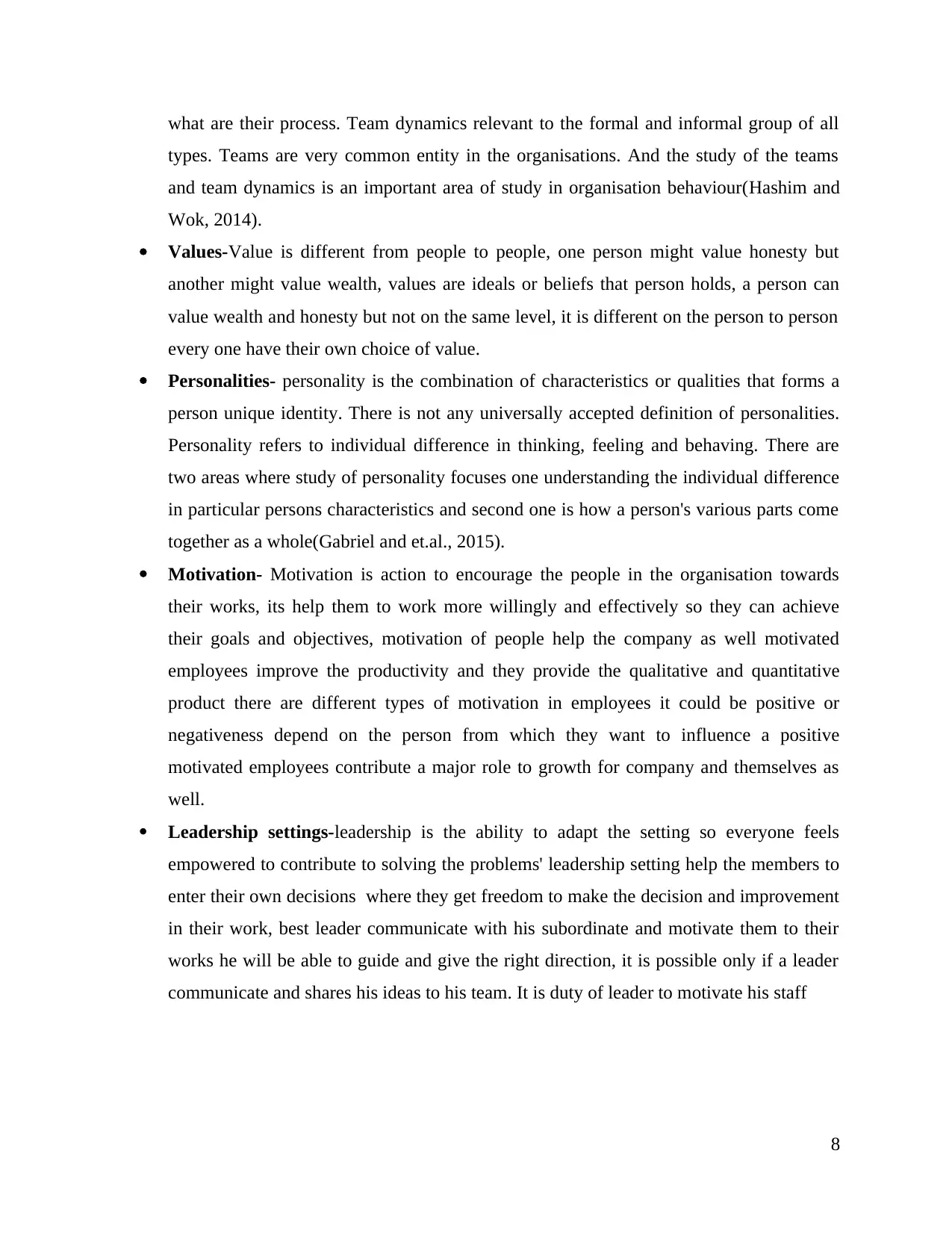
what are their process. Team dynamics relevant to the formal and informal group of all
types. Teams are very common entity in the organisations. And the study of the teams
and team dynamics is an important area of study in organisation behaviour(Hashim and
Wok, 2014).
Values-Value is different from people to people, one person might value honesty but
another might value wealth, values are ideals or beliefs that person holds, a person can
value wealth and honesty but not on the same level, it is different on the person to person
every one have their own choice of value.
Personalities- personality is the combination of characteristics or qualities that forms a
person unique identity. There is not any universally accepted definition of personalities.
Personality refers to individual difference in thinking, feeling and behaving. There are
two areas where study of personality focuses one understanding the individual difference
in particular persons characteristics and second one is how a person's various parts come
together as a whole(Gabriel and et.al., 2015).
Motivation- Motivation is action to encourage the people in the organisation towards
their works, its help them to work more willingly and effectively so they can achieve
their goals and objectives, motivation of people help the company as well motivated
employees improve the productivity and they provide the qualitative and quantitative
product there are different types of motivation in employees it could be positive or
negativeness depend on the person from which they want to influence a positive
motivated employees contribute a major role to growth for company and themselves as
well.
Leadership settings-leadership is the ability to adapt the setting so everyone feels
empowered to contribute to solving the problems' leadership setting help the members to
enter their own decisions where they get freedom to make the decision and improvement
in their work, best leader communicate with his subordinate and motivate them to their
works he will be able to guide and give the right direction, it is possible only if a leader
communicate and shares his ideas to his team. It is duty of leader to motivate his staff
8
types. Teams are very common entity in the organisations. And the study of the teams
and team dynamics is an important area of study in organisation behaviour(Hashim and
Wok, 2014).
Values-Value is different from people to people, one person might value honesty but
another might value wealth, values are ideals or beliefs that person holds, a person can
value wealth and honesty but not on the same level, it is different on the person to person
every one have their own choice of value.
Personalities- personality is the combination of characteristics or qualities that forms a
person unique identity. There is not any universally accepted definition of personalities.
Personality refers to individual difference in thinking, feeling and behaving. There are
two areas where study of personality focuses one understanding the individual difference
in particular persons characteristics and second one is how a person's various parts come
together as a whole(Gabriel and et.al., 2015).
Motivation- Motivation is action to encourage the people in the organisation towards
their works, its help them to work more willingly and effectively so they can achieve
their goals and objectives, motivation of people help the company as well motivated
employees improve the productivity and they provide the qualitative and quantitative
product there are different types of motivation in employees it could be positive or
negativeness depend on the person from which they want to influence a positive
motivated employees contribute a major role to growth for company and themselves as
well.
Leadership settings-leadership is the ability to adapt the setting so everyone feels
empowered to contribute to solving the problems' leadership setting help the members to
enter their own decisions where they get freedom to make the decision and improvement
in their work, best leader communicate with his subordinate and motivate them to their
works he will be able to guide and give the right direction, it is possible only if a leader
communicate and shares his ideas to his team. It is duty of leader to motivate his staff
8
Paraphrase This Document
Need a fresh take? Get an instant paraphrase of this document with our AI Paraphraser
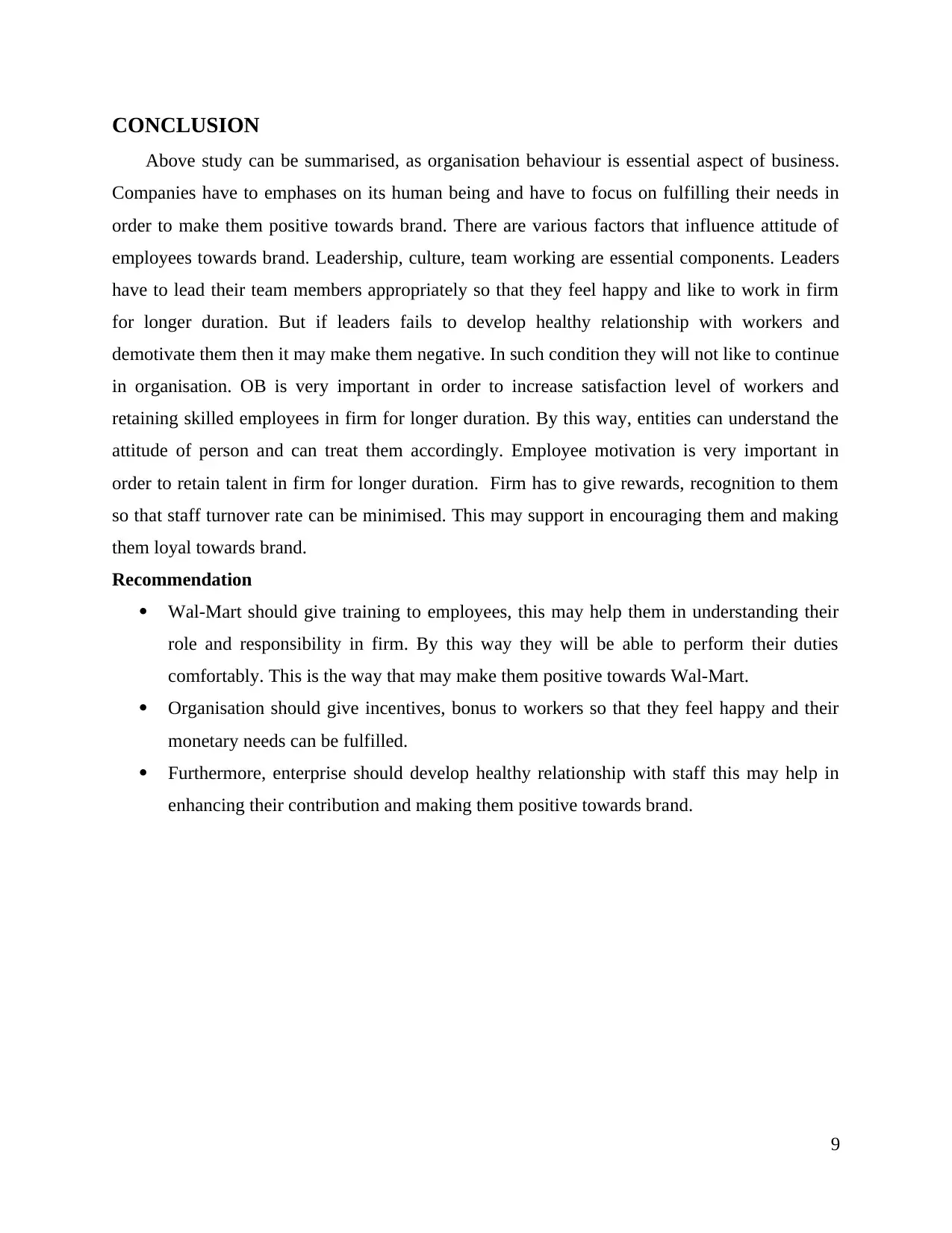
CONCLUSION
Above study can be summarised, as organisation behaviour is essential aspect of business.
Companies have to emphases on its human being and have to focus on fulfilling their needs in
order to make them positive towards brand. There are various factors that influence attitude of
employees towards brand. Leadership, culture, team working are essential components. Leaders
have to lead their team members appropriately so that they feel happy and like to work in firm
for longer duration. But if leaders fails to develop healthy relationship with workers and
demotivate them then it may make them negative. In such condition they will not like to continue
in organisation. OB is very important in order to increase satisfaction level of workers and
retaining skilled employees in firm for longer duration. By this way, entities can understand the
attitude of person and can treat them accordingly. Employee motivation is very important in
order to retain talent in firm for longer duration. Firm has to give rewards, recognition to them
so that staff turnover rate can be minimised. This may support in encouraging them and making
them loyal towards brand.
Recommendation
Wal-Mart should give training to employees, this may help them in understanding their
role and responsibility in firm. By this way they will be able to perform their duties
comfortably. This is the way that may make them positive towards Wal-Mart.
Organisation should give incentives, bonus to workers so that they feel happy and their
monetary needs can be fulfilled.
Furthermore, enterprise should develop healthy relationship with staff this may help in
enhancing their contribution and making them positive towards brand.
9
Above study can be summarised, as organisation behaviour is essential aspect of business.
Companies have to emphases on its human being and have to focus on fulfilling their needs in
order to make them positive towards brand. There are various factors that influence attitude of
employees towards brand. Leadership, culture, team working are essential components. Leaders
have to lead their team members appropriately so that they feel happy and like to work in firm
for longer duration. But if leaders fails to develop healthy relationship with workers and
demotivate them then it may make them negative. In such condition they will not like to continue
in organisation. OB is very important in order to increase satisfaction level of workers and
retaining skilled employees in firm for longer duration. By this way, entities can understand the
attitude of person and can treat them accordingly. Employee motivation is very important in
order to retain talent in firm for longer duration. Firm has to give rewards, recognition to them
so that staff turnover rate can be minimised. This may support in encouraging them and making
them loyal towards brand.
Recommendation
Wal-Mart should give training to employees, this may help them in understanding their
role and responsibility in firm. By this way they will be able to perform their duties
comfortably. This is the way that may make them positive towards Wal-Mart.
Organisation should give incentives, bonus to workers so that they feel happy and their
monetary needs can be fulfilled.
Furthermore, enterprise should develop healthy relationship with staff this may help in
enhancing their contribution and making them positive towards brand.
9
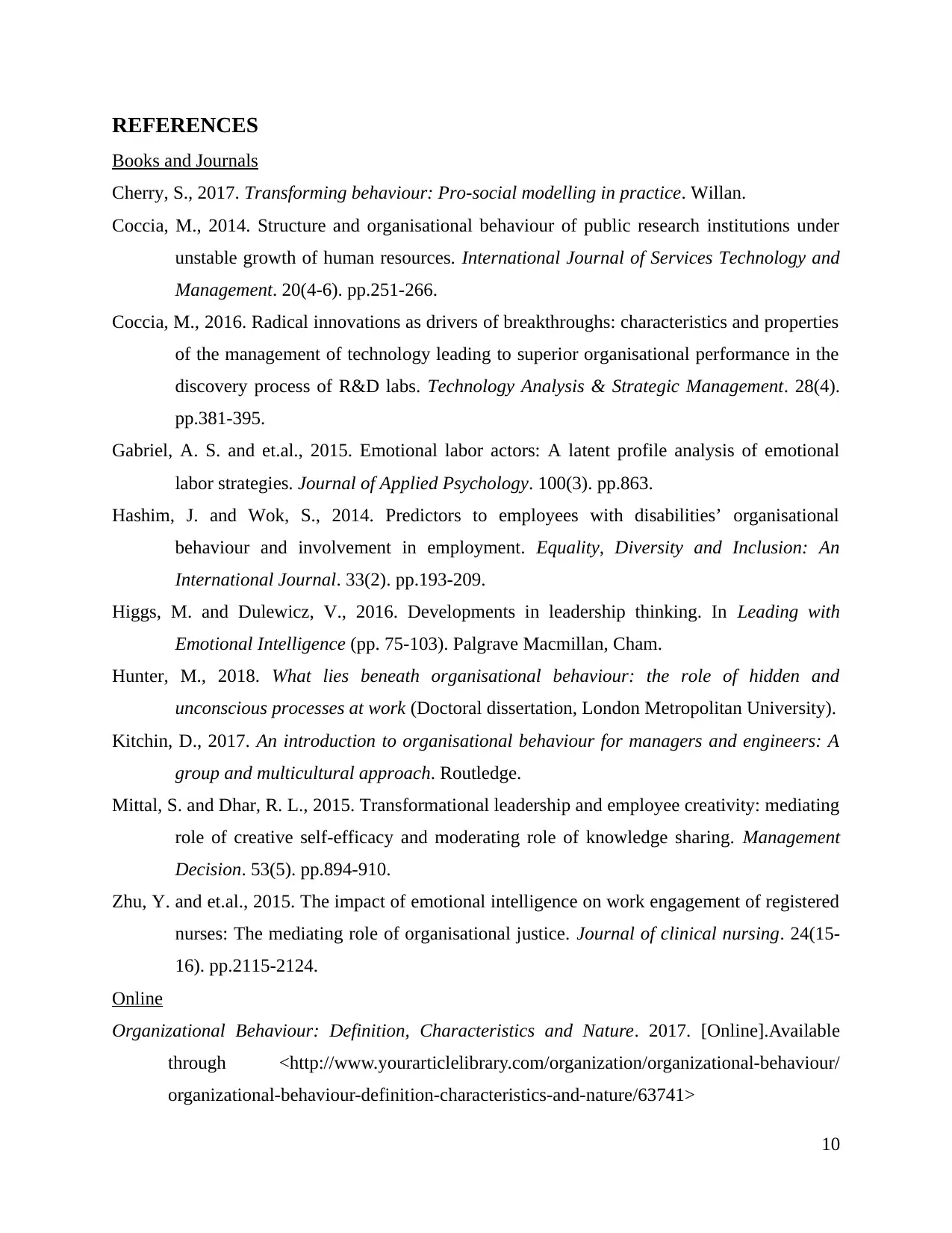
REFERENCES
Books and Journals
Cherry, S., 2017. Transforming behaviour: Pro-social modelling in practice. Willan.
Coccia, M., 2014. Structure and organisational behaviour of public research institutions under
unstable growth of human resources. International Journal of Services Technology and
Management. 20(4-6). pp.251-266.
Coccia, M., 2016. Radical innovations as drivers of breakthroughs: characteristics and properties
of the management of technology leading to superior organisational performance in the
discovery process of R&D labs. Technology Analysis & Strategic Management. 28(4).
pp.381-395.
Gabriel, A. S. and et.al., 2015. Emotional labor actors: A latent profile analysis of emotional
labor strategies. Journal of Applied Psychology. 100(3). pp.863.
Hashim, J. and Wok, S., 2014. Predictors to employees with disabilities’ organisational
behaviour and involvement in employment. Equality, Diversity and Inclusion: An
International Journal. 33(2). pp.193-209.
Higgs, M. and Dulewicz, V., 2016. Developments in leadership thinking. In Leading with
Emotional Intelligence (pp. 75-103). Palgrave Macmillan, Cham.
Hunter, M., 2018. What lies beneath organisational behaviour: the role of hidden and
unconscious processes at work (Doctoral dissertation, London Metropolitan University).
Kitchin, D., 2017. An introduction to organisational behaviour for managers and engineers: A
group and multicultural approach. Routledge.
Mittal, S. and Dhar, R. L., 2015. Transformational leadership and employee creativity: mediating
role of creative self-efficacy and moderating role of knowledge sharing. Management
Decision. 53(5). pp.894-910.
Zhu, Y. and et.al., 2015. The impact of emotional intelligence on work engagement of registered
nurses: The mediating role of organisational justice. Journal of clinical nursing. 24(15-
16). pp.2115-2124.
Online
Organizational Behaviour: Definition, Characteristics and Nature. 2017. [Online].Available
through <http://www.yourarticlelibrary.com/organization/organizational-behaviour/
organizational-behaviour-definition-characteristics-and-nature/63741>
10
Books and Journals
Cherry, S., 2017. Transforming behaviour: Pro-social modelling in practice. Willan.
Coccia, M., 2014. Structure and organisational behaviour of public research institutions under
unstable growth of human resources. International Journal of Services Technology and
Management. 20(4-6). pp.251-266.
Coccia, M., 2016. Radical innovations as drivers of breakthroughs: characteristics and properties
of the management of technology leading to superior organisational performance in the
discovery process of R&D labs. Technology Analysis & Strategic Management. 28(4).
pp.381-395.
Gabriel, A. S. and et.al., 2015. Emotional labor actors: A latent profile analysis of emotional
labor strategies. Journal of Applied Psychology. 100(3). pp.863.
Hashim, J. and Wok, S., 2014. Predictors to employees with disabilities’ organisational
behaviour and involvement in employment. Equality, Diversity and Inclusion: An
International Journal. 33(2). pp.193-209.
Higgs, M. and Dulewicz, V., 2016. Developments in leadership thinking. In Leading with
Emotional Intelligence (pp. 75-103). Palgrave Macmillan, Cham.
Hunter, M., 2018. What lies beneath organisational behaviour: the role of hidden and
unconscious processes at work (Doctoral dissertation, London Metropolitan University).
Kitchin, D., 2017. An introduction to organisational behaviour for managers and engineers: A
group and multicultural approach. Routledge.
Mittal, S. and Dhar, R. L., 2015. Transformational leadership and employee creativity: mediating
role of creative self-efficacy and moderating role of knowledge sharing. Management
Decision. 53(5). pp.894-910.
Zhu, Y. and et.al., 2015. The impact of emotional intelligence on work engagement of registered
nurses: The mediating role of organisational justice. Journal of clinical nursing. 24(15-
16). pp.2115-2124.
Online
Organizational Behaviour: Definition, Characteristics and Nature. 2017. [Online].Available
through <http://www.yourarticlelibrary.com/organization/organizational-behaviour/
organizational-behaviour-definition-characteristics-and-nature/63741>
10
⊘ This is a preview!⊘
Do you want full access?
Subscribe today to unlock all pages.

Trusted by 1+ million students worldwide
1 out of 12
Related Documents
Your All-in-One AI-Powered Toolkit for Academic Success.
+13062052269
info@desklib.com
Available 24*7 on WhatsApp / Email
![[object Object]](/_next/static/media/star-bottom.7253800d.svg)
Unlock your academic potential
Copyright © 2020–2025 A2Z Services. All Rights Reserved. Developed and managed by ZUCOL.




